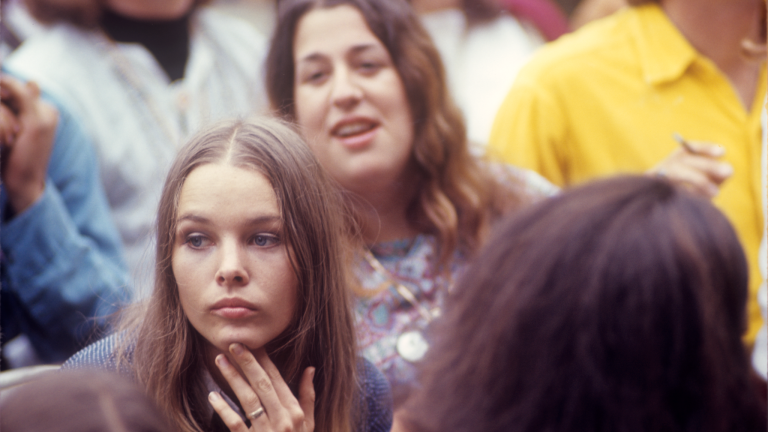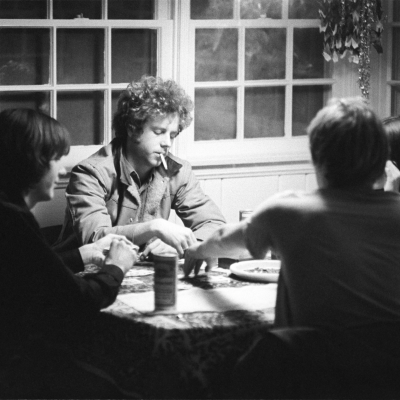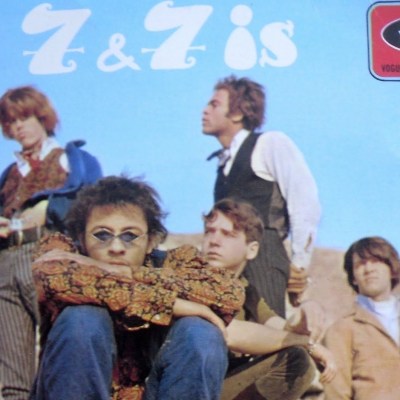Laurel Canyon: Michelle Phillips Looks Back on Her Early California Dreamin’
The Mamas and The Papas’ Michelle Phillips remembers the jams and the plans of Laurel Canyon and explains why she’ll never watch Once Upon a Time in Hollywood.

Epix’s two-part docuseries Laurel Canyon, directed by Alison Elwood, explores the musical community which nestled into the wooded area right outside the Sunset Strip. Chris Hillman, the first member of The Byrds, moved in after creating folk rock. The Monkees’ Mickey Dolenz threw ping pong tournaments next door to Alice Cooper. Frank Zappa planted his freak flag on the corner of Laurel Canyon Boulevard and Lookout Mountain. And Michelle Phillips and John Phillips moved onto Lookout Mountain in 1965.
Their band, The Mamas and the Papas, practically invented the Southern California hippie sound, and Michelle was the catalyst. After hearing John Sebastian strum a tune which would become a major hit for his band The Lovin’ Spoonful, Michelle saw the direction the New Journeymen–the band she was in with her husband and other future Papa Denny Doherty–should go. Both sonically and geographically.
Michelle finished up John Phillips’ song “California Dreamin’” while they were still in dreary New York City with a spiritual flourish inspired by a visit to St. Patrick’s Cathedral. She then returned to her west coast roots to follow that dream. The other Mama in the band, Cass Elliot, who’d moved to New York to make it on Broadway, was also a catalyst. Her house in Laurel Canyon hosted the beginnings of many musical collaborations, including Crosby, Stills, Nash and Young.
The Mamas and The Papas fathered and mothered rock festival shows. Along with record producer Lou Adler (who signed the band to Dunhill Records), Alan Pariser, and The Beatles’ publicist Derek Taylor, they put together The Monterey Pop Festival. The three-day concert, which brought in artists like Jimi Hendrix, Janis Joplin, and The Who, kicked off the Summer of Love.
Michelle was the young rebel in the band. In the Laurel Canyon documentary, hers is the first voice of dissent over certain aspects of utopian nostalgia. She questions the sexual politics of ‘60s Laurel Canyon; and she points out the enlightened decade was too close to the ‘50s to drop double standards as easily as they dropped Owsley Stanley’s original LSD recipe.
Michelle Phillips spoke with Den of Geek about mamas, papas, the California sound and the community at the center of Laurel Canyon, as well as what came after.
You said when you first came to Laurel Canyon you were outsiders and you became the establishment.
Michelle Phillips: We were poor hippies and then we turned into rich hippies.
Graham Nash called Cass Elliot the “Gertrude Stein of Laurel Canyon.” How many bands do you think she’s responsible for? What was her knack?
She was such a wonderful person. She was such fun. She was so funny and she attracted people to her home. Her house was always open and she always had a glass of wine for you. She loved to sing with other people and she loved to have people come over with their guitars and play. She was not a snob in the slightest bit. She welcomed everyone to her home. And consequently, she made a lot of friends in the business.
She put Crosby, Stills, and Nash together. She had always been friends with Crosby, from the day of The Byrds. She just met people all the time. She was invited to every party in the world and she was a very lovely hostess to anybody. You could go there and smoke a joint and spend the night. So she was the Gertrude Stein of Laurel Canyon.
The Mamas and the Papas were instrumental in putting together the Monterey Pop Festival. What was it like being at the center of that international lineup and getting it together?
Well, it just happened so quickly. We had to put the Monterey Pop Festival together in three months and we had to get people to perform for free. Which, in those days, believe me, they couldn’t believe what they were hearing. We wanted them to play for free? But John and Lou were very persuasive, Lou Adler and John Phillips. We were kind of making it up as we went along. They’d say, “Well, where is the money going to go to?” and we’d say, “Well, we’re going to open music schools in Harlem and we’re going to give money to the free clinic.”
The interesting part about all of this is that 50 years later, the Monterey Pop Festival fund is generating hundreds of thousands of dollars a year that still go to charity.
I read that, after Manson, you never invited anyone over to your house again. When you hear the media, and even the documentary, call Charles Manson “hippie,” how do you feel?
Charles Manson was a very sick, sick person. He wasn’t anything but a sick person. He wasn’t a hippie. He was a murderer. I mean, I have not even seen the movie Once Upon a Time in Hollywood because I can’t go back to that period that will torment me for the rest of my life. I was very good friends with Sharon. And even though I know everyone says, “Oh, but the movie ends in a completely different way,” I can’t go back there. I don’t think about Charlie Manson, at all.
The documentary gets into Gram Parsons, and you were a part of the shoot for the science fiction film, Saturation 70. That sounds like a cool Laurel Canyon story. Can you tell me about that?
You mean the movie that we made in Joshua Tree? That was one of those things just kind of came out of the blue. That was actually my very, very, very first movie, but it was never cut together. A lot of the footage was just lost.
It was sure a lot of fun to be in Joshua Tree during the event. It was kind of like an annual festival that they have for extraterrestrial beings. I do have a picture of me in a spacesuit from that picture. That’s where I met Gram. I don’t think I knew Gram before that. It was just a lot of fun. It wasn’t like a real shoot. It wanted to be but I don’t think it ever got to that.
I love your Victims of Romance album. I especially love “Trashy Rumors.”
“Trashy Rumors,” yeah, John wrote that.
The title track is very Phil Spector. You worked with Darlene Love on the song “Basketball Jones.”
Oh, yeah. That was Darlene Love, wasn’t it? Lou just called me one day and said, “I need some backgrounds on this record and I wanted to know if you wanted to come down and sing some backgrounds? I’m getting a couple of other girls together.” I said, “Sure.” It was fun. He produced Cheech & Chong.
I was very happy that he thought of me to come down and do something because at that period in my life, I was still scrambling to try to get some work in film and television, which I eventually did a lot of work in. I’ve worked in film and television for 25 years. I worked in the Mamas and Papas for two and a half.
I found that it was a lot of fun just to go with the flow. When Lou asked me to do that, I just said, “Yeah, I’ll be there. What time are we starting?”
Do you still write songs?
Well, not really. I just wrote a song with my lawyer called “Her Bail’s Been Met.” I’m not really playing and singing that much. It’s just something that, unless I have somebody really prodding me, it’s hard for me to get into writing. If someone wants to write I’ll sit down and try to write with them, but I never really loved writing. I mean, I would have never written anything if it hadn’t been for John. John was writing every moment of the day. If it weren’t for John, I would have never become a singer. I think that I’ve kind of done my writing enough.
I wanted to ask about the writing of “California Dreamin’” and the scene that you were leaving behind. I was wondering who wound up joining you and who you wound up leaving behind in New York?
Well, “California Dreamin’” was actually inspired by my need to get back to California. I did not like living in New York through the winters. I liked New York. I worked a lot in New York. I was doing a lot of modeling in New York and I was making money. I always loved that.
One night, John woke me up in the middle of the night, like two or three in the morning. He said, “Listen to this. I’m writing a song,” and he sang me the first verse of “California Dreamin’.” I said, “Ah, that’s great. Love it.” He says, “Well, wake up. Help me write it.” I said, “Oh, John. I’ll help you write it, but let’s do it tomorrow.” He says, “No, Michelle. Let’s do it right now. Wake up. You’ll thank me for this, someday.”
And I do. I do thank him very much for him expanding my life beyond modeling. I mean I met John at a very important part of my life. I had just turned 17 and I wanted to just meet every musician and I wanted to wear beautiful little cocktail dresses, and my hair up in a chignon, a Brandy Alexander in one hand, a cigarette in the other.
We talked it over with my dad, because I was still in high school. John wanted to take me over to New York. My father wasn’t particularly crazy about this idea but he also was a very pragmatic person. He knew that I could leave anytime I wanted to at that point. And so, he just said, “Michelle, I’ll let you go but always remember you can come home anytime you want.” And off we went to New York.
I just wanted to come back to Los Angeles so badly. And then we wrote “California Dreamin’” and kind of put it away in a drawer. When Denny and Cass and John and I got together, that was the first song we recorded in Los Angeles for Lou Adler. It became a standard, which is saying a lot. I mean, that’s amazing. It always amazes me that I can say that about my talents.
Laurel Canyon airs May 31 and June 7 on Epix.


